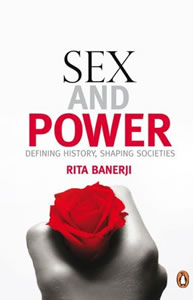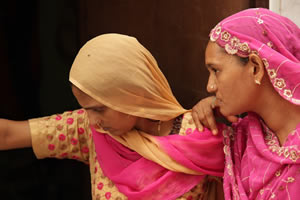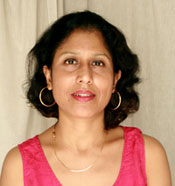Why We Slept Through A Genocide—Part II
 How could I have slept though the annihilation of my own kind? How did I, an Indian woman, live on in such oblivion to the systematic and targeted elimination of millions of Indian women? Why did it evoke no response in me – no anxiety, no outrage, no resistance, no action? Not even involved thought! There is something so indescribable and bizarre about asking that question. I wonder if others belonging to groups that were targets of genocides have done the same?
How could I have slept though the annihilation of my own kind? How did I, an Indian woman, live on in such oblivion to the systematic and targeted elimination of millions of Indian women? Why did it evoke no response in me – no anxiety, no outrage, no resistance, no action? Not even involved thought! There is something so indescribable and bizarre about asking that question. I wonder if others belonging to groups that were targets of genocides have done the same?
In 2004-5, after I had returned to India, and was working on the research for my book Sex and Power, something clicked deep within me. The data on the systemic and mass-scale violence on Indian women and girls I was gathering for my book was playing out in its stark grotesqueness in my everyday reality. A baby girl is abandoned on the streets in my city, and as residents wait for the police to respond, street dogs kill her and start eating her.
A mother throws her new born girl out of the window of a city hospital a few hours after giving birth. The police rescue the child unharmed from the tree she was caught in, and hand her back to the parents. Our domestic help comes in late one morning and informs us that the daughter-in-law in the house next to hers had run out onto the street, fire blazing all over her. She died, and everyone knows she was set on fire though no complaint was filed. The daughter of a close family friend dies within seven years of her marriage under mysterious circumstances. Her parents who had invited us for her wedding, don’t even inform us of her death. They cremate her quietly, and have the doctor write it off as a heart attack. She was only 30.
I saw the connection and for the first time felt uneasy, ashamed and outraged. Yet, I was also conscious that I had grown up in India, regularly hearing about incidents like these. Why didn’t they strike me this way before? Now, after much retrospection I finally understand why.
One, I think to many of us in India the immense scale of the violence and its character was unknown. We’ve dealt with it like families often deal with incestuous abuse. Everyone has or knows a dirty secret and learns to hush it down, till it becomes the dirty secret that an entire nation is participating in, while pretending that no one knows. I think the collation of data by researchers, social activists, and institutions over the last two decades have been very critical to exposing this dirty secret.
 Secondly, I think that the manner in which this issue has been addressed, has completely dehumanized what is in reality a massive human-rights violation of a specific group of people. The ‘missing’ women and girls are referred to as numbers and ratios such that after some time one is not even aware that we are talking about human beings here and a gross infliction of violence against them. More so, there is an attempt to dismiss the role of the perpetrators – be it in the form of the legal system, culture and individuals, such that the way the world has come to view this is as they would news of an earthquake, or hurricane — something that just happens and cannot be controlled. So girls and women in India simply go “missing,” – not that a system comprised of individuals are deciding to and systematically targeting and massacring them.
Secondly, I think that the manner in which this issue has been addressed, has completely dehumanized what is in reality a massive human-rights violation of a specific group of people. The ‘missing’ women and girls are referred to as numbers and ratios such that after some time one is not even aware that we are talking about human beings here and a gross infliction of violence against them. More so, there is an attempt to dismiss the role of the perpetrators – be it in the form of the legal system, culture and individuals, such that the way the world has come to view this is as they would news of an earthquake, or hurricane — something that just happens and cannot be controlled. So girls and women in India simply go “missing,” – not that a system comprised of individuals are deciding to and systematically targeting and massacring them.
A third and very important factor I now realize is the cultural internalization of the dehumanization of women. Yes, I did grow up like everyone else in India hearing about baby girls being trashed and married women being burnt to death – but there is a deep-rooted, cultural conditioning that taught us very early on to disregard these events, to remain unmoved, like we would if we heard news about the weather. If a cow was slaughtered in a Hindu neighborhood, there would be religious riots and reprisals across the country. So very early, those of us who grew up in India – learnt to prioritize the value of different types of lives. The life of a cow was more sacred than the life of a girl or a woman.
What is personal to me, and probably an important factor in changing my culturally conditioned perspectives was my stay in the United States. In 1995, Susan Smith, a young, single, struggling mother in the U.S., had killed her two children, drowning them by pushing her car into a lake. The country responded with shock, outrage and an outpouring of grief. In another incident, Laci Peterson, a young pregnant woman was killed by her husband, in what turned out to be a coldly, premeditated murder for personal gain, as most dowry murders in India are. Again, the public responded with shock, outrage and grief. In both cases it was unacceptable that someone in the life of the children and the young wife, who is trusted with their safety and well-being, would deliberately violate their very basic human rights with such cold, premeditation. When I finally returned to India, the total absence of public response to incidents of brutal violence against girls and women rankled deeply in me. It felt outlandishly abnormal.
Yet over the last 6 years or so as I have worked with The 50 Million Missing Campaign to raise global awareness about the ongoing female genocide in India, I find myself looking back at the women’s and human rights groups in the United States, with equal puzzlement. Their response to the female genocide in India is often patronizing – almost accommodating. ‘Educate the people,’ it is suggested, ‘and they will stop killing females some day.’ This, regardless of the fact, there is no correlation between education, economics and a tendency to eliminate daughters or kill women in India. I wonder, would the same suggestion be made about the killing of blacks in the U.S. or Jews in Europe? And while we are waiting for this misogynistic mindset to change, what do we do about the continued killing of girls and women every few minutes?
I had once asked an American friend, a feminist, what she thought the response of the women’s and human rights groups in the U.S. would have been, if 50 million women had been selectively annihilated there – killed in the millions before and after birth, as girls and as women. She said, “They would have brought down the Capitol with their bare hands!” So I wondered why they would respond differently to the genocide of women in India. Perhaps it is as author Taslima Nasreen observes in her book, No Country For Women. She says that communities tend to view women as the property of the communities they are born and raised in. When the human rights of women in one community are abused, the other community politely looks away. They think: It is “their” women. Let them deal with “their” women the way they see fit. Just as they would, with all matters of personal property.
 Rita Banerji is an author, photographer, and gender activist. She is the founder of The 50 Million Missing Campaign (www.50millionmissing.info), a global lobby that raises international awareness about the ongoing female genocide in India. Born and raised in India, Rita has also lived in the U.S. where she attended Mount Holyoke College (B.A.), and later The George Washington University. Her education and work has largely been in the environmental field, and many of her projects had a gender focus, including one with the grassroots organization, Chipko. She received awards and recognition for her work from The American Association for Women in Science, The Botanical Society of America, The Charles A. Dana Foundation, and The Howard Hughes Foundation. Her book Sex and Power: Defining History, Shaping Societies (Penguin Books, 2008), a historical study of the relationship between sex and power in India, and how it has led to the ongoing female genocide in India, was long-listed for The Vodaphone-Crossword Non- Fiction Book Award (India). Many of her articles published focus on issues of gender, for which she received The Apex Award for Magazine and Journal Writing (U.S.A.) in 2009. Her website is www.ritabanerji.com
Rita Banerji is an author, photographer, and gender activist. She is the founder of The 50 Million Missing Campaign (www.50millionmissing.info), a global lobby that raises international awareness about the ongoing female genocide in India. Born and raised in India, Rita has also lived in the U.S. where she attended Mount Holyoke College (B.A.), and later The George Washington University. Her education and work has largely been in the environmental field, and many of her projects had a gender focus, including one with the grassroots organization, Chipko. She received awards and recognition for her work from The American Association for Women in Science, The Botanical Society of America, The Charles A. Dana Foundation, and The Howard Hughes Foundation. Her book Sex and Power: Defining History, Shaping Societies (Penguin Books, 2008), a historical study of the relationship between sex and power in India, and how it has led to the ongoing female genocide in India, was long-listed for The Vodaphone-Crossword Non- Fiction Book Award (India). Many of her articles published focus on issues of gender, for which she received The Apex Award for Magazine and Journal Writing (U.S.A.) in 2009. Her website is www.ritabanerji.com
The views expressed by guest contributors to the “It’s a Girl” blog represent the opinion of the individual author who contributes the content and should not be interpreted as being endorsed or approved by Shadowline Films. We feature these contributions to foster dialogue and exchange on gendercide and invite our readership to join the discussion.
